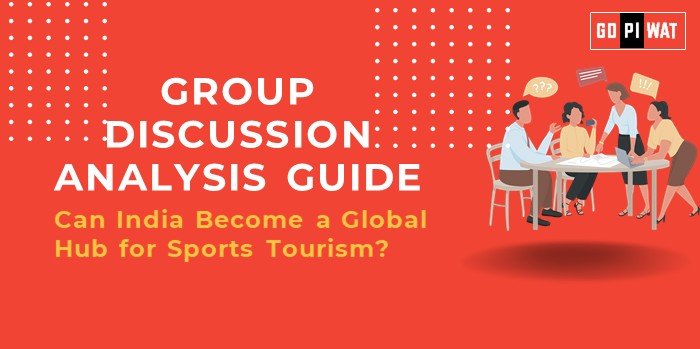📋 Group Discussion (GD) Analysis Guide
Can India Become a Global Hub for Sports Tourism?
🌐 Introduction to Sports Tourism in India
Opening Context: Sports tourism, an industry valued at over $800 billion globally, combines sports and travel, promoting destinations as venues for international sports events. India, with its diverse cultural backdrop and sporting talent, holds immense potential to thrive in this sector.
Topic Background: Historically, India’s sports tourism has revolved around cricket. However, the emergence of leagues like IPL and global events like the 2010 Commonwealth Games has highlighted the nation’s ability to host international events, paving the way for future growth.
📊 Quick Facts and Key Statistics
- Global Sports Tourism Value: $800 billion+ annually, showcasing the industry’s massive scale.
- Sports Infrastructure: ₹3,000+ crore allocated to Khelo India, reflecting India’s commitment to grassroots and professional sports.
- Event Success: IPL contributes ₹11 billion annually to GDP, emphasizing economic potential.
- Tourist Arrivals for Sports: 10% growth in arrivals during IPL seasons, indicating sports-driven tourism boost.
- Global Rank: India ranked 16th in Sporting Nation Brand Index, signaling improvement but with growth opportunities.
🛠️ Stakeholders and Their Roles
- Government: Policy formation, infrastructure investment (e.g., Khelo India, Fit India Movement).
- Sports Bodies: Organizing international events and promoting domestic leagues (e.g., BCCI, ISL, Pro Kabaddi League).
- Tourism Boards: Marketing India as a sports destination, supporting travel infrastructure.
- Private Sector: Sponsorships, stadium management, and talent scouting (e.g., Tata, Reliance).
- International Federations: Approving India as a host for international events.
🏆 Achievements and Challenges
🎉 Achievements:
- Global Recognition: Successful hosting of ICC Cricket World Cup, IPL, and Commonwealth Games.
- Economic Impact: ₹4,000+ crore contribution from major sports events in 2023 alone.
- Infrastructure Growth: Facilities like Narendra Modi Stadium in Ahmedabad, one of the largest globally.
- Grassroots Development: Programs like Khelo India creating a robust talent pipeline.
⚠️ Challenges:
- Infrastructure Gaps: Limited facilities outside metro cities.
- Bureaucratic Hurdles: Delays in approvals and regulatory red tape.
- Security Concerns: Past incidents, e.g., 2009 Sri Lankan cricket team attack, raise safety issues.
- Global Comparison: Countries like Qatar (FIFA 2022) and Japan (Olympics 2021) outpace India in preparedness.
📖 Case Studies
- Kerala’s Tourism Model: Integration of sports with cultural festivals for increased footfall.
- IPL’s Economic Impact: Generates employment and boosts local economies.
📌 Structured Arguments for Discussion
- Supporting Stance: “India’s diversity, coupled with emerging sports leagues, positions it as a top contender for global sports tourism.”
- Opposing Stance: “Without addressing infrastructure deficits and bureaucratic inefficiencies, India’s ambitions may remain unrealized.”
- Balanced Perspective: “While India shows promise with marquee events like IPL, it must enhance its infrastructure and global competitiveness.”
✨ Effective Discussion Approaches
- Opening Approaches:
- Start with impactful data: “Sports tourism generates $800 billion globally, and India is a growing player in this industry.”
- Use a case study: “The IPL model showcases India’s capability to merge sports and tourism.”
- Highlight global parallels: “Countries like Qatar have leveraged sports for global branding, a roadmap India could follow.”
- Counter-Argument Handling:
- Acknowledge gaps in rural infrastructure and present solutions such as PPP models.
- Emphasize progress in urban centers and grassroots initiatives like Khelo India.
📈 Strategic Analysis of Strengths and Weaknesses
- Strengths: Established cricket dominance; government support for sports infrastructure.
- Weaknesses: Inconsistent policies across states; limited international marketing.
- Opportunities: Leveraging 5G for immersive sports experiences; collaborations with global sports federations.
- Threats: Competition from established hubs like Europe and the Middle East; security and safety concerns.
💼 Connecting with B-School Applications
- Real-World Applications: Case studies on sports-driven urban development (e.g., Ahmedabad and IPL); project themes on PPP models in sports infrastructure.
- Sample Interview Questions:
- “How can India compete with Qatar or Japan in sports tourism?”
- “Evaluate the economic impact of IPL on local businesses.”
- Insights for B-School Students:
- Explore intersections of marketing, logistics, and event management in sports.
- Leverage data analytics to enhance fan engagement and tourism planning.


